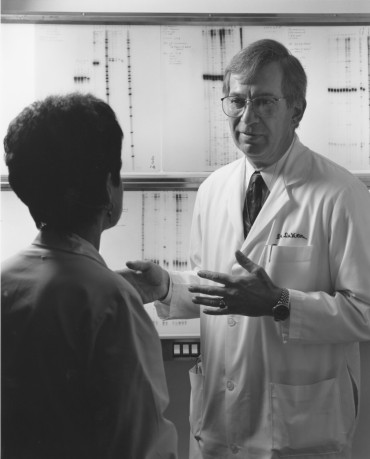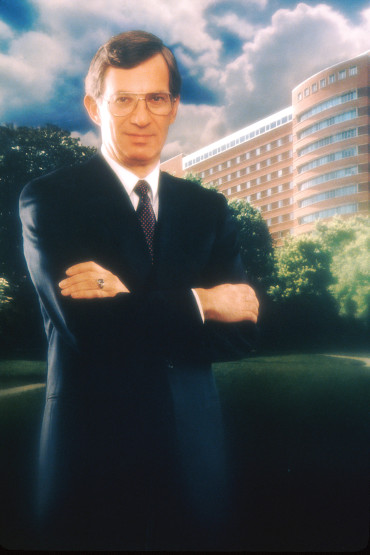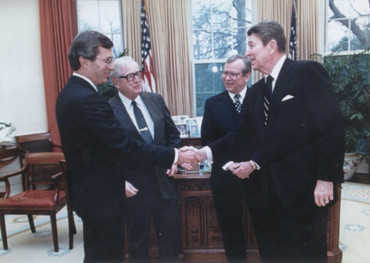Life on the Front Lines
Pioneering Oncologist Dr. Vincent DeVita Looks Back on 50 Years and Looks Ahead to Victory in the War on Cancer
July 1, 2016
Sara Piccini

FAMILY AFFAIR: Oncologist Vince DeVita Jr. '57, D.Sc. '82 (left) with wife Mary Kay Bush DeVita '57 (right) and their daughter, Elizabeth DeVita Raeburn
Photo by Don Hammerman
In 2009, Dr. Vincent DeVita Jr. ’57, D.Sc. ’82, an internationally renowned oncologist, was diagnosed with advanced prostate cancer. His prognosis looked grim.
DeVita spent the first week in a daze. “I was viewing the information from the eyes of a doctor who’s seen patients die of this disease, and imagining the worst,” DeVita says. “So I got a colleague to help me. He took my case, blinded my name, and presented it to all the leading urologic surgeons.
“Most of them, including the most famous one in this country, said they would not operate on me.”
As DeVita recounts in his new book, The Death of Cancer — co-written with his daughter, Elizabeth DeVita-Raeburn ’88 — he eventually found a surgeon willing to operate. He remains cancer-free today.
DeVita’s experience reinforces the primary message of his book: we are winning the war on cancer. “We can now successfully treat 68 percent of all people with cancer,” he says. “When I started out, it was 38 percent.”
But, he argues, we could and should be doing even better. “Too often, lives are tragically ended not by cancer but by bureaucracy, by review boards, by the FDA, and by doctors who won’t stand by their patients or who are afraid to take a chance.”
“There’s information in the book that I think people with cancer, or family members with cancer, need to know about the way that oncology is practiced in this country that is not talked about by the establishment,” Elizabeth adds.
DeVita is uniquely qualified to tell the inside story about the war on cancer. As a young doctor at the National Cancer Institute (NCI) in the 1960s, he helped to pioneer the use of combination chemotherapy and developed the first successful treatment for Hodgkin’s lymphoma. He went on to play a pivotal role in the passage of the National Cancer Act of 1971.
In 1980, President Carter appointed DeVita director of the NCI and the National Cancer Program, a position he held until 1988. DeVita subsequently served as physician-in-chief at Memorial Sloan Kettering Cancer Center and director of the Yale Cancer Center. DeVita is also co-editor of the leading textbook on cancer, now in its 10th edition.
“For the past half-century, he has been at the forefront of the fight against one of the world’s most feared diseases,” writes New Yorker reviewer Malcolm Gladwell. “And in The Death of Cancer he has written an extraordinary chronicle.”
PIONEERS AND HEROES
DeVita began his career intending to become a cardiologist, not an oncologist. If not for an encounter with William & Mary chemistry professor Alfred Armstrong, however, he might not have become a doctor at all.
“I was walking on campus and he was walking ahead of me,” DeVita recalls. “I was trying to make sure I didn’t walk fast enough to catch him.” DeVita, a chemistry major, had recently joined a fraternity and knew his grades were slipping.
I thought I had a lot of empathy with patients and their families, that I understood what they were going through, but I had to experience it myself to really understand.
“I can take you almost to the brick where he stopped. He turned around and talked to me for five to 10 minutes about what was happening with my grades and why. I didn’t realize somebody was watching out for me. I just pulled up my socks and wound up doing very well.
“When I was given an honorary degree at William & Mary, he came to the podium and he had a copy of one of my tests. He’d saved a pipette that I’d used — it was very touching.”
“That interaction — that’s part of the strength of the school,” says Mary Kay Bush DeVita ’57, who met her husband while they were undergraduates at the College.
After graduating from medical school with honors from George Washington University thanks to his rigorous undergraduate education, and completing his advanced training, DeVita sought a position at the National Heart Institute to fulfill his public service obligation during the Vietnam War. By his own admission he “blew the interview” and fate landed him at the NCI as a clinical associate in the fall of 1963.
At that time, few scientists were focused on finding new treatments for cancer. “As a newcomer to the field back in those days, the thought that you could actually cure cancer with drugs was considered a higher form of insanity,” DeVita says. “Everyone knew you couldn’t cure cancer. And if you couldn’t cure it, you didn’t treat it. And if you didn’t treat it, it was indeed incurable.”
DeVita found himself working with a group of maverick doctors led by Tom Frei and Emil Freireich, who were developing a protocol using combination chemotherapy to treat childhood leukemia. “I wasn’t sure if these scientists were maniacs or geniuses,” he recalls in the book. (He recounts a raucous party he and Mary Kay attended early on, where the 6-foot, 4-inch Freireich ended up passed out in the bathtub.)
Inspired by Frei and Freireich’s results, DeVita and colleague Jack Moxley set out to develop a drug protocol for Hodgkin’s lymphoma, which at that time was nearly always fatal. They came up with a combination of four drugs called by the acronym MOMP. The results of the first trial were remarkable — 12 of the 14 patients went into remission — but the medical establishment remained unmoved.
DeVita then refined the combination, creating MOPP, which had a four-year remission rate of 80 percent. Many skeptical doctors were finally ready to acknowledge the efficacy of combination chemotherapy. In 1972, DeVita shared the prestigious Lasker Award with Frei, Freireich and other NCI pioneers. Chemotherapy, later termed medical oncology, became an official subspecialty of medicine in 1974.
For DeVita, the real heroes of the story are not the doctors, but the patients. Without the drugs available today to alleviate the side effects of chemotherapy, patients receiving the MOPP regimen suffered constant bouts of vomiting, mouth sores, and more.
“The people who had the guts were the patients who put their lives in our hands. They were told they were going to die and thought they had little to lose — but still, we were young, in our early 30s. Medically, it was courageous. That’s why we dedicated the book to them.”
A PRIVATE BATTLE
Promoted to chief of medicine and then director of the treatment division at the NCI, DeVita became a public face in the war on cancer throughout the 1970s — meeting with Congressmen and government officials, testifying on Capitol Hill, and fighting interagency battles.
At the same time, DeVita and his family were fighting a very private battle of their own.
In 1972, Vincent and Mary Kay learned that their 9-year-old son, Ted, had developed an extremely rare condition called aplastic anemia.

ON THE JOB: DeVita discusses lab results with a researcher at Yale Cancer Center where he served as director from 1993-2004. He is now the Amy and Joseph Perella Professor of Medicine at Yale.
His bone marrow was no longer producing blood cells and platelets, making him defenseless against infection. Elizabeth was only 5 years old at the time.
Ted spent the next eight and a half years in a specially designed laminar airflow room at the NCI, originally designed for leukemia patients, just one floor above the wards where his father treated cancer patients. The only human touch he experienced was through plastic gloves. DeVita explored every possible avenue to find a treatment. “We tried to do with my son what I’ve done with other patients, but we just didn’t succeed,” he says.
“I thought I had a lot of empathy with patients and their families, that I understood what they were going through, but I had to experience it myself to really understand.”
From their vantage point on the front lines in the cancer battle, the DeVitas have seen numerous families shatter from the impact of coping with a deadly disease. Vince DeVita credits his wife for holding their own family together. “Mary Kay was the strongest person I’ve ever seen during this,” he says. “I could hide in my job and have my mind directed away from it; Mary Kay and Elizabeth couldn’t.”
In 2004, Elizabeth published The Empty Room: Understanding Sibling Loss, a recollection of her life with Ted and a deep exploration of the impact of losing a sibling. “Elizabeth bore a burden that we didn’t appreciate until she wrote the book. We tried to protect her from information,” DeVita says. “All it was doing was making her more frightened.”
“Everything about me is related to that experience,” Elizabeth says. “In terms of the work that I do, it’s very informed by it. I can see the full spectrum when I’m writing about science, what it means for the patient. The projects that I pick are about making things better for someone, because otherwise it’s not worth my life’s energy.”
“It certainly defined us as who we are today,” Mary Kay says. “It brought out the best in all of us, including our son.
“He was a little boy when he went into that room and he became the most amazing young man. He conquered the room.”

THE DIRECTOR: DeVita stands for his official portrait after being appointed director of the National Cancer Institute by President Jimmy Carter in 1980.
On May 27, 1980, Ted finally succumbed to his disease. Two months later, DeVita was sworn in as director of the NCI. In his official portrait, the NCI’s clinical center appears in the background, with the window of Ted’s 13th floor room clearly visible.
FATHER-AND-DAUGHTER CO-AUTHORS
During DeVita’s tenure as NCI director, Swem Library contacted him with a request for his papers. By this time, he’d saved files and files of irreplaceable documents that others wanted to toss. Swem agreed to take it all.
In an NIH oral history recorded in 1997, DeVita told the interviewer, “I received a letter from William & Mary a year ago that they had now catalogued everything. All I have to do is find the time to write a book on the war on cancer.”
It would take almost two decades, but DeVita eventually did find the time to begin work on The Death of Cancer. In the intervening years, he lobbied relentlessly for advances in the lab to be quickly translated into patient treatment.
His initial experience “in the real world of cancer care” as physician-in-chief at Memorial Sloan Kettering Cancer Center — considered the premier cancer institution in the country — was disheartening, and he spent five years butting heads with physicians and administrators. (When he resigned in 1993, his boss reportedly told the department chairs, “The problem with Vince is that he wants to cure cancer.”)
DeVita has seen continued improvements since that time at his own institution, Yale Cancer Center, and throughout the country. He contends in The Death of Cancer, however, that we could be curing an additional 100,000 patients a year.
In setting out to write his book, DeVita knew that he’d need a co-author. “People told me it’s always a mistake to work with your family,” he says. “But I realized that Elizabeth had a lot more information since she was with us for the whole process. So she took over.”
DeVita handed his daughter a manuscript of 320,000 words. He got back 110,000 words. “I almost had a heart attack,” he says. “But then I read it and said, ‘This is good.’ She recognized the good stories. She also brought a lot of warmth. Many times Elizabeth and Mary Kay would be sitting there talking with me, and Elizabeth would ask, ‘Well, where were you, what was happening at the office, what does the office look like, what color are the walls?’ — things that I would never, as a medical person, bring into a story. I knew she was good; I just didn’t realize how good she was.”

DeVita was reappointed director of the National Institute of Cancer by President Ronald Reagan in 1981.
For Elizabeth, the collaboration gave her an opportunity rarely available to children to view the full scope of a parent’s life. “I was there for it, but my perspective was that of a child. Working on the book, I got to understand my father’s life in a much more in-depth, rich way than I would have otherwise.”
“It turned out to be an absolutely fabulous experience,” DeVita says. “Writing the book with Elizabeth was one of the greatest experiences of my career.”
“THE BEST IS YET TO COME”
Now the Amy and Joseph Perella Professor of Medicine at Yale, DeVita has no plans for retirement. He is consulting with Congress on the new National Cancer Moonshot Initiative, headed up by Vice President Joe Biden, and working on the 11th edition of Cancer: Principles and Practice of Oncology.
DeVita will be on sabbatical this fall, and the family will come home to William & Mary. He and Elizabeth plan to review his papers in the Swem archives with the intention of writing a second book.
Under the tutelage of Frei and Freireich, DeVita learned never to give up hope. “To dedicate yourself to helping people survive, especially to survive this disease, you had to be an eternal optimist,” he writes.
He remains optimistic. “If a doctor tells you, ‘There’s nothing I can do for you,’ find another doctor. There’s something we can do for virtually anyone with cancer. And the best is yet to come.”